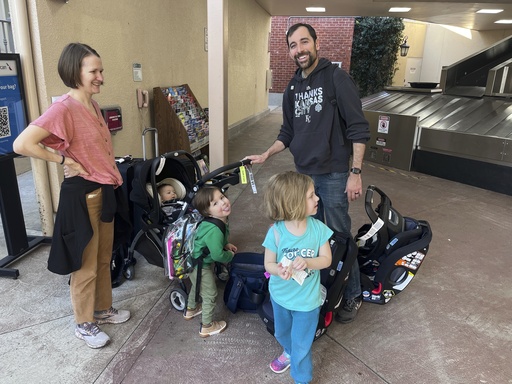
The recent emergency landing of a Delta Air Lines flight in Toronto has drawn attention to the hazards associated with flying while holding a young child on a parent’s lap. The incident, which resulted in the aircraft flipping over, underscores the difficulties in securely holding a child in such a situation.
Although officials have not confirmed whether an 18-month-old who sustained injuries was seated on a parent’s lap during the incident, it is worth noting that all 21 people who were hurt received treatment and were later discharged from the hospital. However, past aviation accidents have seen fatalities among young children, emphasizing the inherent risks.
While airline crashes are infrequent, the threat of injury to children on laps during unexpected turbulence remains a significant concern for aviation safety experts. Many of these professionals advocate for children under the age of two to occupy their own seats equipped with appropriate car seats, even if this necessitates an additional ticket purchase. However, due to regulations permitting lap-sitting, many parents continue to opt for this practice despite the associated dangers.
Former flight attendant Jan Brown recounted a heartbreaking experience after a 1989 crash near Sioux City, Iowa, where she interacted with a grieving mother who lost her 22-month-old son. The mother had followed the advice of airline protocols, trusting that having her child on the floor would be safe. Brown’s advocacy for child seat safety began from this tragic encounter, highlighting the disconnect between legal allowances and actual safety.
In another incident, a tragic event occurred in 2012 when a 6-month-old boy lost his life during a hard landing in Nunavut, Canada while being held on a parent’s lap. Furthermore, in a 2022 incident, three infants on laps nearly faced dire consequences when part of an aircraft’s door dislodged mid-flight, emphasizing the unpredictability of air travel.
The National Transportation Safety Board (NTSB) along with Canada’s Transportation Safety Board have consistently advocated for young children to travel in their own secured car seats. Although the Federal Aviation Administration (FAA) endorses these recommendations, they have yet to make them mandatory. Organizations such as the American Academy of Pediatrics and various airline trade unions echo this sentiment, cautioning against the risks involved when children are not properly restrained.
After a series of catastrophic accidents in previous decades, authorities in both the United States and Canada have recommended that children under 2 years old utilize car seats, and that older children use specialized restraint systems, especially those under 40 inches tall.
NTSB member Tom Chapman explained why many parents might hesitate to purchase an extra ticket, highlighting the financial strain on families. “Everyone has been in the position of trying to economize when traveling with young kids,” he noted. This underscores a general lack of awareness regarding the risks parents pose to their children by choosing to forgo proper restraint.
On another note, utilizing individual seats not only enhances safety but also brings convenience for parents, who are spared the challenge of managing a restless child during flights. Michelle Pratt, a car seat specialist and founder of Safe in the Seat, encourages families to invest in tickets for each child, emphasizing the relative affordability compared to checked luggage costs.
Responses from parents vary widely; for instance, Clare Ronning, arriving in Burbank, California, with her baby, expressed skepticism about the need for a car seat on an aircraft, equating it to an unnecessary expense. Conversely, Meredith Tobitsch firmly believes in the necessity of securing her 14-month-old in a seat, citing safety and her child’s improved comfort during flights.
The issue of the FAA not mandating additional tickets for young children stems from a 1990s study suggesting that such requirements might push families to opt for potentially riskier road travel instead. However, Chapman argues that this rationale is outdated and should be reassessed in light of current ticket prices.
Parent Andrea Arredondo acknowledged this dilemma, admitting that purchasing an additional seat for her 4-month-old might deter her family from flying altogether, as managing travel logistics with multiple children can be demanding.
In summary, while the debate continues over the safety of flying with children on laps versus in secured seats, the tragic incidents of the past and the ongoing endorsements from safety advocates emphasize the need for more stringent regulations to protect young passengers on flights.

